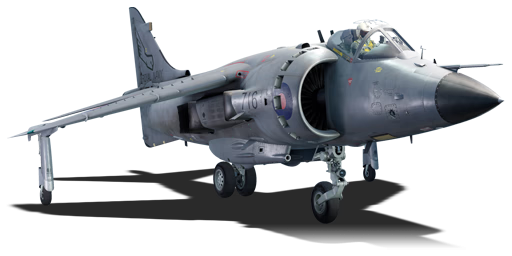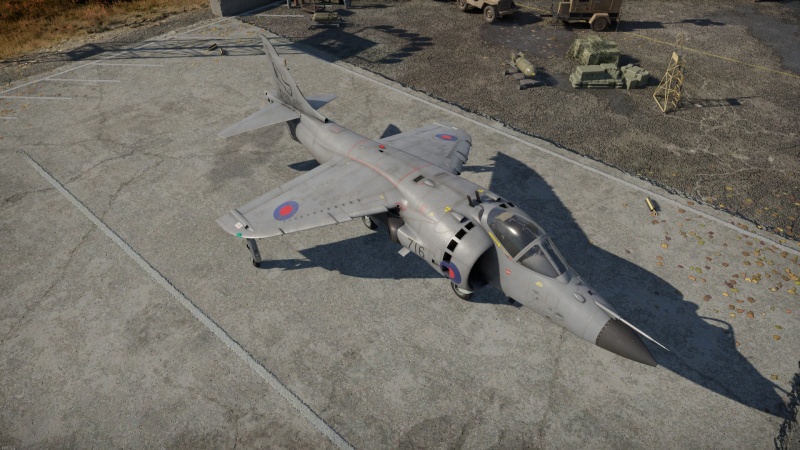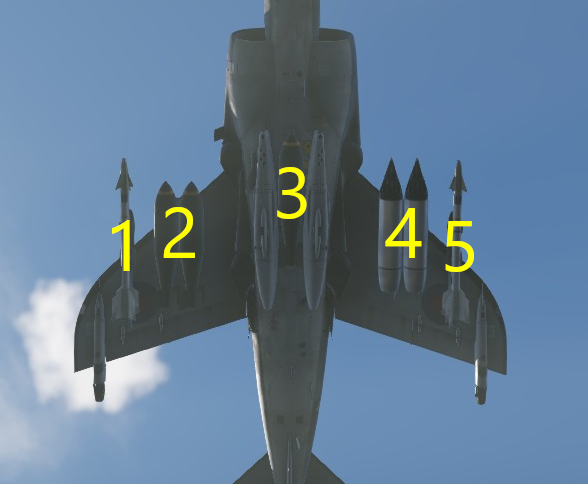Sea Harrier FRS.1
| This page is about the squadron British strike aircraft Sea Harrier FRS.1. For the regular version, see Sea Harrier FRS.1 (e). For other versions, see Harrier (Family). |
Contents
Description
The Sea Harrier FRS.1 was a specialised version of the Hawker-Siddeley Harrier, designed for naval operations. It joined the Royal Navy of the United Kingdom in 1978 and gained fame for its role in the Falklands War in 1982, where it defended the fleet from enemy aircraft attacks with great success. Despite being vastly outnumbered, the Sea Harriers shot down 21 Argentinean planes without losing any of their own, a remarkable accomplishment that demonstrated the superiority of the aircraft. In a subsequent upgrade, the Sea Harrier FRS.1 was equipped with a 2x2 Aim-9L configuration, further enhancing its air combat capabilities.
The Sea Harrier FRS.1 was introduced in Update "Apex Predators". The Sea Harrier is available as an option for rank VII through unlock as a squadron vehicle. It can present experienced pilots familiar with the GR.1/3 with a further improvement in the form of deadly AIM-9L Sidewinder missiles and a unique position since it is one of the few Harrier versions in game equipped with a radar. Ultimately, the Sea Harrier builds on the strengths of the Harrier GR.3 with improved air-to-air combat capability. However this comes at a cost of being heavier and slightly more sluggish than its contemporaries. All in all, the Sea Harrier can be a powerful opponent in the hands of a veteran pilot and provides an almost preparatory experience for the Harrier GR.7.
General info
Flight performance
The Sea Harrier possesses a flight performance very similar to the aircraft it is derived from, the Harrier GR.3, possessing the same Pegasus 103 engine. It is worth noting however that the Sea Harrier carries additional weight in the form of the radar equipment within its nose and an altered aerodynamic profile to accommodate this.
Comparatively, the Sea Harrier turns more sluggishly than contemporary Harriers, but it still maintains the exceptional thrust and climb rate prevalent among its kind, able to climb up to lofty heights where it can maximise the range potential of its all-aspect AIM-9L Sidewinder missiles. It comes with the same thrust vectoring of other Harriers allowing the aircraft to pull tighter turns and make split second adjustments at the cost of speed and energy.
| Characteristics | Max speed (km/h at 0 m - sea level) |
Max altitude (metres) |
Turn time (seconds) |
Rate of climb (metres/second) |
Take-off run (metres) | |||
|---|---|---|---|---|---|---|---|---|
| AB | RB | AB | RB | AB | RB | |||
| Stock | 1,150 | 1,144 | 12192 | 32.5 | 34.0 | 70.2 | 68.5 | 550 |
| Upgraded | 1,168 | 1,159 | 31.5 | 32.0 | 105.2 | 87.0 | ||
Details
| Features | |||||
|---|---|---|---|---|---|
| Combat flaps | Take-off flaps | Landing flaps | Air brakes | Arrestor gear | Drogue chute |
| X | ✓ | ✓ | ✓ | X | X |
| Limits | ||||||
|---|---|---|---|---|---|---|
| Wings (km/h) | Gear (km/h) | Flaps (km/h) | Max Static G | |||
| Combat | Take-off | Landing | + | - | ||
| 1191 | 648 | N/A | 829 | 556 | ~14 | ~6 |
| Optimal velocities (km/h) | |||
|---|---|---|---|
| Ailerons | Rudder | Elevators | Radiator |
| < 648 | < 950 | < 790 | N/A |
Engine performance
| Engine | Aircraft mass | ||||||
|---|---|---|---|---|---|---|---|
| Engine name | Number | Basic mass | Wing loading (full fuel) | ||||
| Rolls-Royce Pegasus Mk.104 | 1 | 6,258 kg | 462 kg/m2 | ||||
| Engine characteristics | Mass with fuel (no weapons load) | Max Gross Weight | |||||
| Weight (each) | Type | 9m fuel | 20m fuel | 30m fuel | 33m fuel | ||
| 1,650 kg | Vectored-thrust low-bypass turbofan | 6,959 kg | 7,661 kg | 8,363 kg | 8,593 kg | 11,409 kg | |
| Maximum engine thrust @ 0 m (RB/SB) | Thrust to weight ratio @ 0 m (WEP) | ||||||
| Condition | 100% | WEP | 9m fuel | 20m fuel | 30m fuel | 33m fuel | MGW |
| Stationary | 9,150 kgf | 9,709 kgf | 1.40 | 1.27 | 1.16 | 1.13 | 0.85 |
| Optimal | 9,150 kgf (0 km/h) |
9,709 kgf (0 km/h) |
1.40 | 1.27 | 1.16 | 1.13 | 0.85 |
Survivability and armour
The Sea Harrier FRS.1 possesses no armour. All of its internal modules are arrayed in close proximity within the fuselage centred around the engine.
The Sea Harrier is not a sturdy aircraft and can be destroyed fairly easily owing to its compact assembly. However, if the damage taken is not enough to outright down the Harrier such as damage to flaps or wings, the Harrier can in an emergency leverage its thrust vectoring to compensate for lift lost from wing damage and limp back to the airfield for repair at the cost of being exceptionally vulnerable to enemy aircraft on the way.
Modifications and economy
As with most aircraft at the tier the Sea Harrier competes at, it is advisable to prioritise unlocking the Flare/Chaff upgrade to greatly increase survivability of the Harrier against very commonly encountered IR missiles. After which, pursuing the unlock of the Sea Harrier's own AIM-9L Sidewinder capability is highly recommended as this will encompass most of the jet's offensive capability when dealing with other aircraft.
A further advantageous unlock would be to acquire the 1,000 lb bombs which can be grabbed while prioritising the unlock of the AIM-9L's: these will allow unlocking further upgrades and RP by bombing bases before turning to engage enemy aircraft. Once sufficient weapons and countermeasures are unlocked then it is recommended to focus entirely on flight performance upgrades to make the most of the superb climbing and thrust of the Pegasus engine.
Recommended path:
Flares/Chaff -> 1000 LB bombs -> New Boosters -> AIM-9L -> Wings Repair -> Engine -> Compressor -> Cover -> Airframe -> Fuselage Repair -> G-suit > EFS -> Offensive 30 mm belts -> New 30 mm cannons -> Matra No7 Mk 1 rockets
Armaments
| Ballistic Computer | |||
|---|---|---|---|
| CCIP (Guns) | CCIP (Rockets) | CCIP (Bombs) | CCRP (Bombs) |
| |
|
|
|
Offensive armament
The Sea Harrier FRS.1 is armed with:
- A choice between two presets:
- 2 x 30 mm ADEN Mk.4 cannons, belly-mounted (130 rpg = 260 total)
- 2 x 30 mm ADEN Mk.4 cannons + 60 x countermeasures
The 30 mm ADEN cannons are identical to those found on the GR.1/3 and the AV-8A/C found in the USA tech tree. These are very hard-hitting guns that can bring down an enemy aircraft with even glancing blows. However on the Harrier family they are often located low on the belly in an awkward spot, possess low muzzle velocity, and often very limited ammunition. They can however be used to great effect on larger aircraft such as A-10s or Su-25s when a quick and snappy burst needs to do fatal damage.
Suspended armament
The Sea Harrier FRS.1 can be outfitted with the following ordnance:
| 1 | 2 | 3 | 4 | 5 | ||
|---|---|---|---|---|---|---|
| 1,000 lb H.E. M.C. Mk.13 bombs | 1, 2 | 1 | 1, 2 | |||
| 1,000 lb H.E. M.C. Mk.13 No.117 bombs | 1, 2 | 1 | 1, 2 | |||
| RP rockets | 36 | 36 | ||||
| AIM-9G Sidewinder missiles | 1 | 1 | ||||
| AIM-9L Sidewinder missiles | 1, 2 | 1, 2 |
| Default weapon presets | |
|---|---|
| |
AIM-9G Sidewinder missile:
The AIM-9G is a potent missile but may begin to feel a little lacklustre at the BR the Sea Harrier operates at. The stock missile option for the Sea Harrier and only able to hold 2 of them on wing-mounted pylons. 9Gs are rear-aspect only but come with a very large seeker cage, 18G of maximum overload and the option for radar-slaving which the Sea Harrier is uniquely able to capitalise on amongst its brethren Harriers. When employing these with the Harrier in particular, it is advisable to deploy them from an altitude advantage on unaware enemies.
AIM-9L Sidewinder missile:
The AIM-9L is a further upgrade of the Sidewinder missile. It retains the radar-slaving capability of the 9G but with a much smaller seeker cage. However instead the 9L now enables the Sidewinder to have all-aspect functionality and up to 30G of maximum overload. This greatly enhances the killing and lock-acquiring capability of the missile with the added benefit of some flare-resistance which will be noticeable especially when firing from a rear-aspect on an aircraft with an afterburner. A potent missile which can be used more widely than the 9G with particular regards to the Sea Harrier, but again is very strong capitalising on the climb rate of the sea Harrier to be deployed almost in a 'sniping' way.
1000 LB Mk.13 bomb:
A common bomb found on British aircraft, the Mk.13 can be employed with the onboard CCIP to be accurately delivered and the Harrier can carry a maximum of 5 alongside its AAM loadout of choice. A full payload of these bombs can destroy a single base in Air battles and are sufficient to destroy enemy armoured vehicles in ground battles with a TNT explosive equivalent of 296.48 kg per bomb.
RP rocket:
The Harrier can carry up to 72 RP rockets, these rockets are simple and can be aimed using the onboard CCIP. Each rocket is equivalent to 691.2 g of TNT and will require multiple hits to damage light vehicles to the point of destruction. However with only 10 mm of penetration these rockets will see little to no effect on MBTs or more thoroughly armoured vehicles.
Usage in battles
Use the Sea Harrier's quick takeoff and climb to ascend high above the normal altitude for battle, somewhere around 5-8 km depending on the map and approaching enemies. Due to the lacklustre turn capabilities and muzzle velocity of the cannons, it's not recommended to engage in dogfights. Instead, use your AIM-9Ls to your advantage and target enemies already engaged or simply oblivious to your presence above them. When done correctly and carefully, this can quietly get you 2-3 kills in a single flyout.
Your cannons are also effective at destroying ground targets which can provide extra RP and SL once your missiles are expended. The Sea Harrier may also carry unguided rockets or bombs for additional ground pounding at the further expense of performance. However, it's important to note that you are at a disadvantage at lower altitude since you cannot climb as fast as other jets at the BR, and it's hard to shake off and outrun an opponent once they're on your tail. MiG-21s, F-5s, and J35s will easily outmanoeuvre you, and A-10s, Su-25s and Su-22s, while slower, can still outturn you and easily put you in their sights.
Pros and cons
Pros:
- Retains the great climb rate and thrust of earlier Harrier's
- Addition of a search radar that can be used to slave the AAM's the Harrier can bring for off-angle shots
- 4 powerful AIM-9L all-aspect missiles
Cons:
- Subsonic in a bracket mostly populated with supersonic aircraft
- Sluggish in its turn radius
- Engines will overheat if run for too long at 100% throttle, management is required
- Limited WEP
History
Describe the history of the creation and combat usage of the aircraft in more detail than in the introduction. If the historical reference turns out to be too long, take it to a separate article, taking a link to the article about the vehicle and adding a block "/History" (example: https://wiki.warthunder.com/(Vehicle-name)/History) and add a link to it here using the main template. Be sure to reference text and sources by using <ref></ref>, as well as adding them at the end of the article with <references />. This section may also include the vehicle's dev blog entry (if applicable) and the in-game encyclopedia description (under === In-game description ===, also if applicable).
Media
- Skins
See also
External links
| British Aerospace plc | |
|---|---|
| Strike Aircraft | Harrier GR.7 · Sea Harrier FRS.1 (e) · Sea Harrier FRS.1 · Sea Harrier FA 2 |
| See also | British Aircraft Corporation · Hawker Aircraft Limited |
| Britain jet aircraft | |
|---|---|
| Blackburn | Buccaneer S.1 · Buccaneer S.2 · Buccaneer S.2B |
| British Aerospace | Harrier GR.7 · Sea Harrier FRS.1 (e) · Sea Harrier FRS.1 · Sea Harrier FA 2 |
| British Aircraft Corporation | Strikemaster Mk.88 |
| English Electric | Canberra B Mk 2 · Canberra B (I) Mk 6 · Lightning F.6 · Lightning F.53 |
| Gloster | Meteor F Mk 3 · Sea Meteor F Mk 3 · Meteor F Mk 4 G.41F · Meteor F Mk 4 G.41G · Meteor F Mk 8 G.41K · Meteor F Mk.8 Reaper |
| Javelin F.(A.W.) Mk.9 | |
| de Havilland | Vampire F.B.5 · Venom FB.4 · Sea Venom FAW 20 · Sea Vixen F.A.W. Mk.2 |
| Hawker | Sea Hawk FGA.6 · Hunter F.1 · Hunter F.6 · Hunter FGA.9 · Harrier GR.1 · Harrier GR.3 |
| Panavia | Tornado GR.1 · Tornado GR.4 · Tornado F.3 · Tornado F.3 Late |
| SEPECAT | Jaguar GR.1 · Jaguar GR.1A · Jaguar IS |
| Supermarine | Attacker FB 1 · Attacker FB.2 · Scimitar F Mk.1 · Swift F.1 · Swift F.7 |
| Foreign | Phantom FG.1 (USA) · Phantom FGR.2 (USA) · F-4J(UK) Phantom II (USA) |
| Australia | F-111C |
| India | ▄MiG-21 Bison |
| South Africa | ▄JAS39C |
| Squadron aircraft | |
|---|---|
| USA | A-4E Early · F-117 |
| Germany | Me 262 A-1a/U1 · ◌Hunter F.58 |
| USSR | Su-22M3 |
| Britain | Firecrest · Sea Harrier FRS.1 |
| Japan | ▄F-5E FCU |
| China | JF-17 |






